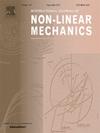Design and experimentation of radial magnetic field vibration energy harvester based on magnetic levitation
IF 3.2
3区 工程技术
Q2 MECHANICS
International Journal of Non-Linear Mechanics
Pub Date : 2025-09-20
DOI:10.1016/j.ijnonlinmec.2025.105266
引用次数: 0
Abstract
Electromagnetic vibration energy harvesters (EVEHs) present a sustainable power solution for sensor networks in the Internet of Things. Most of the EVEHs commonly adopt the axial magnetization structure. Notably, when the magnet moves to the coil's center, the axially radiated magnetic flux lines become nearly parallel to the coil, reducing flux variation and weakening the induced current. Maintaining an effective operating area requires a significant gap between the magnet and coil, which diminishes magnetic field strength and limits device compactness. To address the problem, a radially magnetized electromechanical energy conversion unit is proposed. The magnetic flux lines radially radiated by the magnet remain highly orthogonal to the surrounding coils, increasing flux variation and enhancing electromagnetic induction. The finite element method is used to optimize the coil parameters of the radial magnetized structure, and the induced current is significantly higher than that of the axial magnetized structure. We developed a single-degree-of-freedom (SDoF-MLVEH) and a two-degree-of-freedom (TDoF-MLVEH) magnetic-levitation vibration energy harvester based on the radial magnetization structure. Two types of MLVEHs are validated using a semi-analytical approach based on harmonic balance. Simulations show that TDoF-MLVEH collects about six times more energy than SDoF-MLVEH under rail vehicle axle box excitation. Experimental results verify that the TDoF-MLVEH maintains stable output within the 0.5–1.5 g excitation range, achieving a peak power of 48.76 mW. Compared to the SDoF-MLVEH, the TDoF-MLVEH attains 66.10 % and 88.75 % higher peak power at the first and second resonant frequencies, respectively.
基于磁悬浮的径向磁场振动能量采集器的设计与实验
电磁振动能量采集器(evhs)为物联网传感器网络提供了一种可持续的电源解决方案。大多数ehs通常采用轴向磁化结构。值得注意的是,当磁体移动到线圈中心时,轴向辐射的磁通量线几乎与线圈平行,减少了磁通量变化,减弱了感应电流。维持一个有效的操作区域需要在磁铁和线圈之间有一个显著的间隙,这降低了磁场强度并限制了设备的紧凑性。为了解决这一问题,提出了一种径向磁化的机电能量转换装置。磁体向径向辐射的磁通量线与周围线圈保持高度正交,增加了磁通量变化,增强了电磁感应。采用有限元法对径向磁化结构的线圈参数进行优化,感应电流明显高于轴向磁化结构。研制了一种基于径向磁化结构的单自由度(SDoF-MLVEH)和两自由度(TDoF-MLVEH)磁悬浮振动能量采集器。采用基于谐波平衡的半解析方法对两种类型的MLVEHs进行了验证。仿真结果表明,在轨道车辆轴箱激励下,TDoF-MLVEH收集的能量是SDoF-MLVEH的6倍左右。实验结果表明,TDoF-MLVEH在0.5 ~ 1.5 g激励范围内保持稳定输出,峰值功率为48.76 mW。与SDoF-MLVEH相比,TDoF-MLVEH在第一和第二谐振频率处的峰值功率分别提高了66.10%和88.75%。
本文章由计算机程序翻译,如有差异,请以英文原文为准。
求助全文
约1分钟内获得全文
求助全文
来源期刊
CiteScore
5.50
自引率
9.40%
发文量
192
审稿时长
67 days
期刊介绍:
The International Journal of Non-Linear Mechanics provides a specific medium for dissemination of high-quality research results in the various areas of theoretical, applied, and experimental mechanics of solids, fluids, structures, and systems where the phenomena are inherently non-linear.
The journal brings together original results in non-linear problems in elasticity, plasticity, dynamics, vibrations, wave-propagation, rheology, fluid-structure interaction systems, stability, biomechanics, micro- and nano-structures, materials, metamaterials, and in other diverse areas.
Papers may be analytical, computational or experimental in nature. Treatments of non-linear differential equations wherein solutions and properties of solutions are emphasized but physical aspects are not adequately relevant, will not be considered for possible publication. Both deterministic and stochastic approaches are fostered. Contributions pertaining to both established and emerging fields are encouraged.

 求助内容:
求助内容: 应助结果提醒方式:
应助结果提醒方式:


